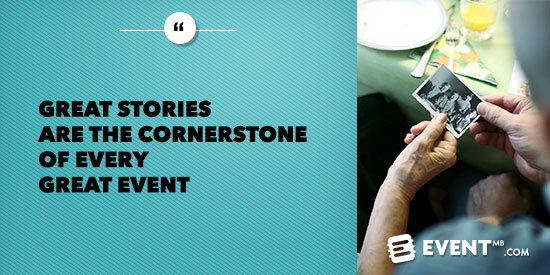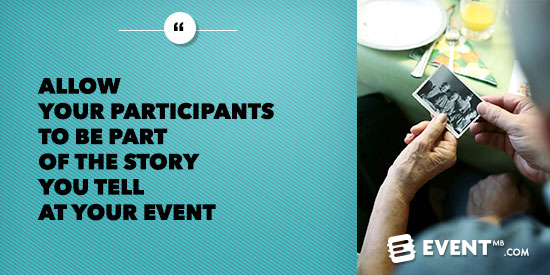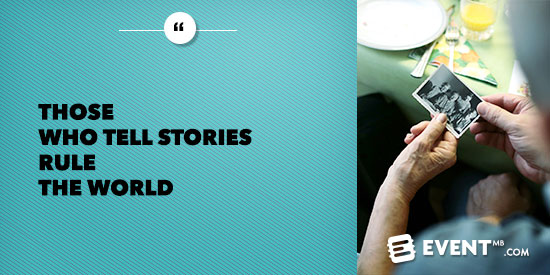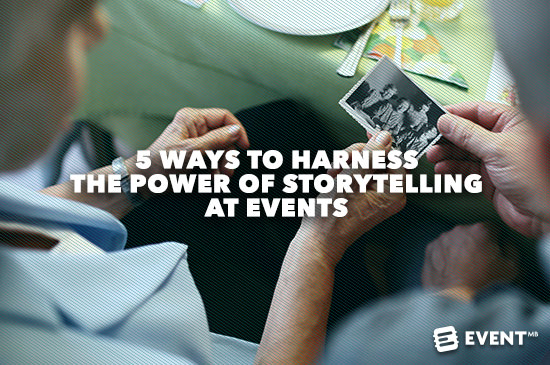An engaging, attention-grabbing story will make anyone sit up and listen. Great stories are the cornerstone of every great event, but harnessing their true potential is often overlooked in the planning phase. Here are 5 unique ways to utilize storytelling at your next event.

When we talk about stories in the event planning world, they are mostly attached to methodology for brand exposure or for speakers to pass off information in a unique way. But storytelling can be used for so much more than selling or educating. Stories can transform an entire event, start to finish and inform the tone for the next event. Here are some different ways event professionals can incorporate the use of stories across their events:
Make it Relatable
Our brains spark magical neural connections with storytellers when hearing a fantastic tale. If we relate to a story, we are much more likely to remember it and connect it to an existing memory. In order to be effective your marketing materials, keynote and breakout speakers, brand activations, and even entertainment needs to be contextual.
Start by drilling down to the essence of your key objective and then expand on it – like an advertising agency would do with a new ad campaign. Often, speakers hijack programs with personal anecdotes and long winded stories that, while motivational, have little to do with the reason for the meeting. If Skittles was planning a conference to help participants understand their ‘Taste the Rainbow’ campaign, a keynote about overcoming adversity might not be as impactful as, say, a moving story about seeing a double rainbow in the sky. Your stories have to relate back to the content in some way, or they will get lost in emotion, or worse…confusion.
Connect the Dots
Tangential stories are not always a bad thing. Sometimes to make a larger point you have to expand on a related concept so that your participants can understand the main story better. Think about how difficult it would be to knit a patchwork quilt without even knowing how to hold your knitting needles. We must help our participants connect the dots by setting them up for success from the beginning: tease out the story you want to tell at your event in the marketing materials. Pose interesting questions pre-conference that get people talking. Probe participants for their insight on your announced topic(s) early on. Consider using innovative techniques to ensure retention, like Color and Advance.
Mix up the Medium

In the iconic words of Marshall McLuhan, “the medium is the message”. The way you deliver your story determines its impact on your participants; so have fun with it! Allow your participants to be part of the story you tell at your event. Weddings are a great example of this because each guest is invited to become part of the Bride and Groom’s love story, and help tell that story through the ages by being part of their special day. Your event sponsors are another great example because they are all clamouring to tell their story in whatever possible way they can; through interactive games, emotional videos, or swag giveaways with narrative branding attached.
Think about how you can get across your event objectives by telling a story in a unique way; pre-event through engaging marketing techniques, at the event with interactive educational sessions, and post-event through open forums and social media prompts.
Get Creative
Choose Your Own Adventure books are incredibly popular for children because they not only put power in the hands of the reader, they allow the reader to discover several unique, successful or unsuccessful ways to get from the start to the end of the story. The story itself might be the same, but it’s up to the person observing the story to find it’s truth and get some meaning out of it. Why not apply the same concept to your event? Let your participants discover their own story within the bigger story of your program, then showcase it in a unique way, for example visually by creating an image that shares an impactful memory from the program – like Dear World does.
You could also apply this concept to the overall program by having participants choose the path (or learning track) ahead of time and craft each track so that it follows a sequential ‘story’ finishing with an end goal; the end to their story. For example, if I was on the “Learning to Negotiate” track at a conference, I might start with an introduction to public speaking class and end with a masterclass on assertiveness. My journey to becoming a negotiating ninja would then be told by the way I approach the program: my story!
Leverage It
Beyond simply using storytelling to sell tickets or aid in retention at education sessions, crafting a story around your event extends the shelf life of your message. Every great story gets passed around out of excitement – think of all the silly stories that go viral online every day. There’s power in the people, and power in your participants and their networks. A event planner friend of mine experienced a huge bump in business after she started hand selecting, framing, and sending off group photos from her events to her clients as a reminder of the wonderful memories they created and the positive ‘story’ of her events. Social media is another great tool to continue the conversation (and give prospective participants FOMO for the next one) – and there are even dedicated apps for generating stories from hashtags that can pull your event together into a cohesive narrative for the outside world to see.
In Conclusion

Every event should tell a memorable story that lasts beyond the confines of its venue. Think about the unique ways you can weave the power of storytelling into every component of your event when you begin your design phase for maximum impact, and remember, those who tell stories rule the world.





